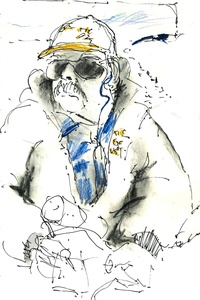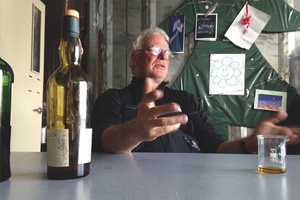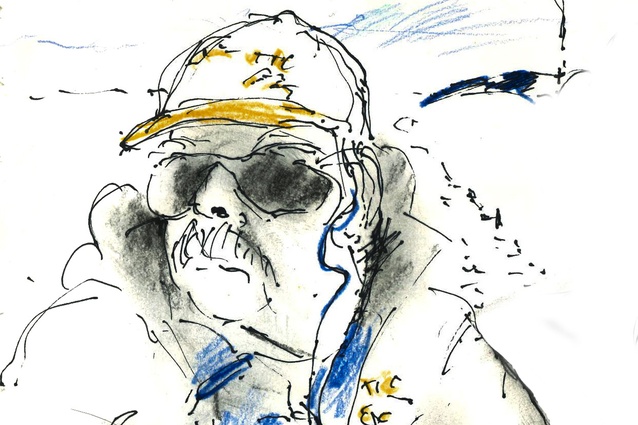The size of things
I am trying to figure out the size of things, as I have been for most of my life. At various times I have seized on books, those handbooks stuffed full of drawings and dimensions. I have given to them all the authority of tablets received from on high.
I liked the certainty they delivered: the comfort of knowing a British or European standard person required only so much space to stand in front of a clothes washer and just so much more to do the ironing. These tomes, the AJ Metric Handbook, Ramsay and Sleeper, Neudorf and others were the holy scripts of functional design, prescriptive schema which would guide us to well-functioning buildings.
The spatial certainty these books offered was matched by the near-endless stream of hot tips that one could glean from Sunset books, a series that got one sorted on everything from Kung Pao chicken to great ideas for storage. There were early days when we did so many villa alterations that we challenged each other to record the house to be altered perfectly with the least number of measurements – was it an 1150-wide hall or the 1850? I was shamed by the brevity of our surveys when Jeremey Salmond’s authoritative Old New Zealand Houses appeared, yet harbour still the desire to do an alteration that has the existing plan drawn up on the basis of a record-breaking seven measurements and covered with references to, for example, page 42, Sunset book on storage and page 16, Sunset book on staircases.
Designing Q Theatre a few years later, we discovered a fatal flaw in prescriptive texts that we are increasingly aware: that many of Q’s hoped-for audience of Pacifika people are of a more robust frame than we puny palagi and that the separation of seats into discrete handbook-dictated dimensions did not easily accommodate an audience less inclined to sitting isolated in the dark. And so I rather belatedly discovered the mute authority of tabulated dimension was not without cultural baggage and that one needed to look and think a bit more widely than simply consulting a well-fingered text. This gave rise to simulations in the studio as we set seats apart to mimic the distance between opposing balconies in the planned theatre and argued the toss; was 20 metres too far apart to feel part of an audience ensemble, or should it be 19.5, or maybe 18.75…?
Inevitably increasing work on the bespoke had me filling pages of notebooks with dimensions and sketched details, balancing on ceiling joists in an attic coercing a steel tape to stand without support for four or five metres so that I might later deduce rules from my hieroglyphics the ridge height and thus the degree of infringement of planning rules. Though well overtaken now by the GPS-located machinery of contemporary surveying, the skills learned teetering in that attic stood me in good stead as three of us placated an irate sea lion long enough to map a tree-covered hillside in the very deep south. Those southern expeditions were marked by a sense that we were only here once; the logistics of getting us to the sites so long-planned, complex and expensive that the gaining of every measurement that might aid the later reconstruction of the site from the comfort of one’s studio was vital, sea lion, permafrost, darkness and subzero temperatures notwithstanding.

On one such expedition, I was accompanied by ‘the Duke’, an historian and collector of polar memorabilia and whose measurements consisted of mapping gatherings: who was sitting where, at what time, and what the thrust of the conversation was. The result was a notebook stuffed with his own hieroglyphics, memorably including the apparently fortuitous meeting on the sea ice, miles from anywhere, of two bright red Hägglunds, the preferred mode of transport in those parts: one accommodating a reporter from The New York Times in search of our party for the inside scoop on the conversation of the huts to which we were headed, in the other. As we completed our interview, the Duke’s journal kept pace with who said what as we stamped our feet and slid around that vast McMurdo ice shelf.
As with the Q Theatre work, this was empirical research, the fine-grained recording of human interaction, missing only the measurement of distance between speaker and listener. Perhaps, too, there might have been some recording of physiological response: the speaker’s blood pressure rising in uncertainty, or the dilation of the listener’s iris revealing a liminal response. Measurement and recording is a wonderful triumph of human experience over those imperious numerals laid out in the metric handbooks. Did they ever take account of the almost imperceptible flicker of the eyes upwards, sure sign of a half-truth being hatched? No, of course not. Casting aside the parameters of modernity and its tabulated dictates; we are free to immerse ourselves in the close observation of experience, the space between chairs and tables measured in bruises and knocked shins.
The sizing of public open space is a much more complicated business, one that is increasingly important as housing shrinks and public spaces increasingly provide the social hubs of our lives. I was musing on this the other day as I found myself caught up in a community of swimmers gathering in the early morning to take the waters. The group had been summoned by an app; called to a lovely arc of sand, pōhutukawa above and protecting reef, and there to greet one another with hearty affirmations of the fitness of weather and water for the immersion ahead. My early return to the beach after a brief, wheezy dip left me plenty of time to ask again a question to which I often return: how big is big, and the attendant and more critical question of what made my sandy cove such a successful public space? At issue is the balance between privacy and intimacy and the making of space that facilitates social interaction.
The contrast between the shallow arc of sand with a small grass hinterland where the swimmers mustered and the cold, white walls of a laundromat experienced a week or so later was extreme. The cheerful exuberance of those fighting into neoprene and goggles contrasted with the silence of downcast eyes as smalls were loaded into serried machines under the cold, fluorescent lighting of the suburban mall. Of course, there are many things in play here, the shared experience of braving the waters, the iPhone’s daily chirping call to the beach contrast cruelly with the dull drudgery of Sunday morning domestic chores. Yet both are interactions in the public realm, the experience of neighbours doing their washing at the local laundromat needs no lesser care than the carefully mown lawn and warm after-swim shower provided at the beach.

This is our métier, our raison d’être. As the barriers of land cost and interest rates move inwards to corral would-be homeowners like the walls in Edgar Alan Poe’s The Pit and the Pendulum, it is no one person’s place on which we must lavish our attentions. We will always make individual houses alright using our genius and hard work, but the need is elsewhere now. It is public space, our new living rooms, on which we must concentrate. We must cast aside the dull pragmatism of
those who, in ignorance or the absence of more humane criteria, will turn to their own seemingly immutable rules and cast the space in terms of turning radii and separation distances. Alas, like our discussion on seat size and format years ago at Q, there are many more things in play than hard and fast rules will resolve. We need to be alert to the subtleties of success wherever we find it, maybe even the sandy edge of the Pacific.
Pip Cheshire is an architect and writer, recipient of the NZIA Gold Medal and Past President of the New Zealand Institute of Architects.










